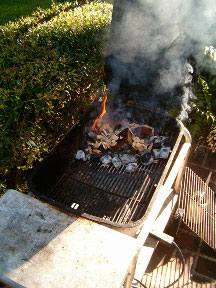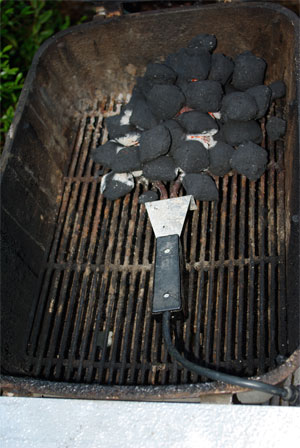
We love the TV commercial where the stadium-parking-lot-full of grillers all fire their grills at the same moment, with a great big BANG of flames and smoke. It amazes us that so many people could get it so wrong. Now, see, we can't even remember what they were advertising, but our first guess would be beer.
Lighting your grill should be a very easy, Zen-type of thing, with no bang, no whooosh, no smell of eyebrows burning. OK - there are those who claim we are taking all the fun out of it, but we'll stick by our guns on this issue - you should not risk personal injury when you light your grill.
Your first consideration is whether to use only hardwood coal, or a mixture of hardwood and briquettes. When cooking meats that need a hot, fast fire, we use the hardwood only. When we need a lower fire with some lasting ability, we use at least half briquettes. For a long-lasting, braising-type meat, we use mostly briquettes combined with big, wet wood chunks.
You will need a minimum of about 2 quarts of charcoal for even the easiest, fastest dish, though we've been known to cook a burger on five briquettes. As a visual guide, a milk carton will hold roughly 2 quarts of coals, and the average charcoal chimney starter about the same - maybe a little more. If you are cooking something big that will require a lot of time, go on and fire up about 6 quarts of coals - this will keep you from having to immediately start stoking the fire and give your dish a good head start. Your bed of charcoal should always be slightly larger than the food you are cooking over it - and the higher you pile the coals, the higher the temperature at the level of the grill.
See our section on Charcoal Starters to learn about our fav electric starter, and how to use a charcoal chimney to get the fire going. It's now time to decide how to bank the fire.
You have three choices: 1) a modified two-level fire; 2) a two-level fire; and 3) a single level fire. "Level" does not refer to a vertical element, but a degree of temperature set out on a horizontal plane. A single level fire is a bed of coals evenly spread out over the bottom of the grill. It is evenly hot all over. This works for fast-cooking things like vegetables, fruits, fish, and shellfish.
A two-level fire has the horizontal bed of the grill divided into two temperature zones - hot and warm - by banking three-quarters of the coals on one side of the grill, and spreading the rest over the remaining bed of the grill. This allows fast, high-heat cooking to start meats like chops, steaks, bone-in chicken - then moving them to the cooler side of the grill to prevent charring before they are cooked through. We use this configuration for most of our family cooking chores.
A modified two-level fire works best for meats that require a long cooking time. Again, it divides the coal bed horizontally into a hot zone and a MUCH cooler zone. All the coals are piled to one side of the grill and the other side is left empty. This configuration works like a smoker - the meat cooks on the cooler side of the grill, and the fire and smoker is maintained on the other side of the pit. In a large pit or grill, it is beneficial to cover the meat with a disposable aluminium pan to reduce the size of the "oven" and concentrate heat. We use this configuration for braising beef brisket and pork butt, but it's great to smoke mullet, too! Anything that cooks a long time will do best on this set up.

